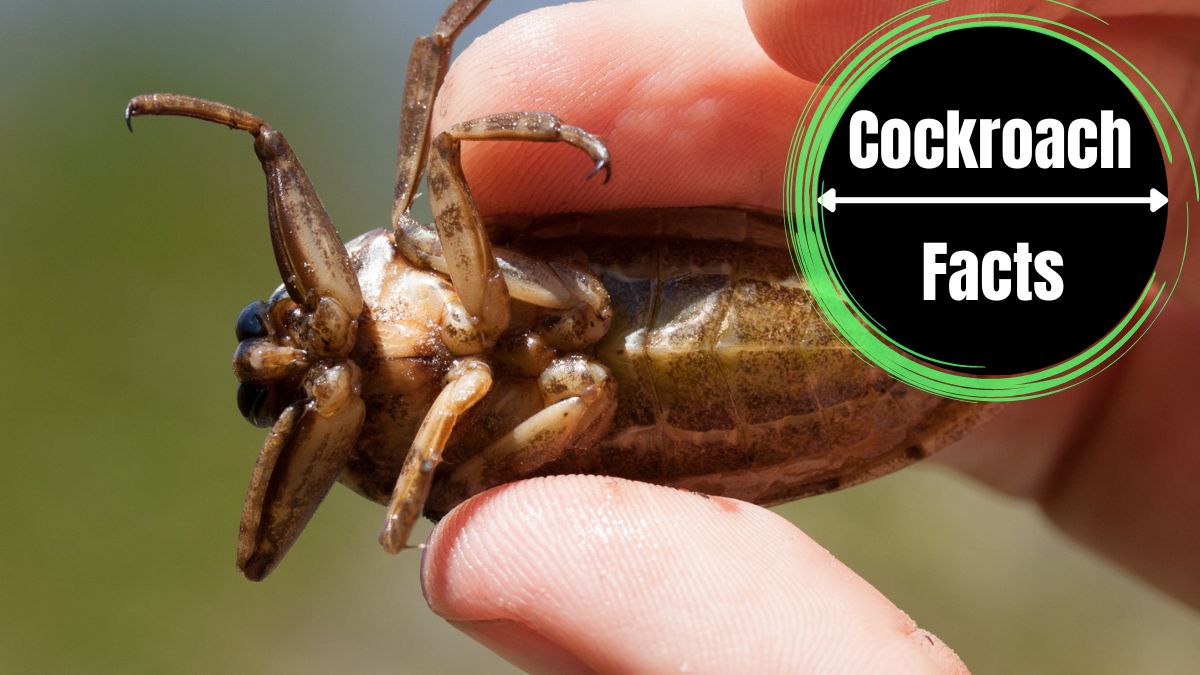Water bugs are a type of insect that lives in or near water. There are many types of water bugs, which can vary in size, shape, and color. Some common water bug types include backswimmers, water Boatmen, and giant water bugs. Water bugs are general predators using their long beaks to puncture and inject their prey with venom. This venom can be harmful to humans, so it is important to be able to identify water bugs if you come into contact with them.
American Water Bug
The American water bug is a large, predatory insect found in freshwater habitats throughout North America. These insects are highly adapted to their aquatic environment and can swim and walk on the water’s surface. American water bugs are voracious predators and will feed on various small animals, including fish, amphibians, and reptiles. These insects are a nuisance to humans, as they are often attracted to swimming pools and can bite if handled.
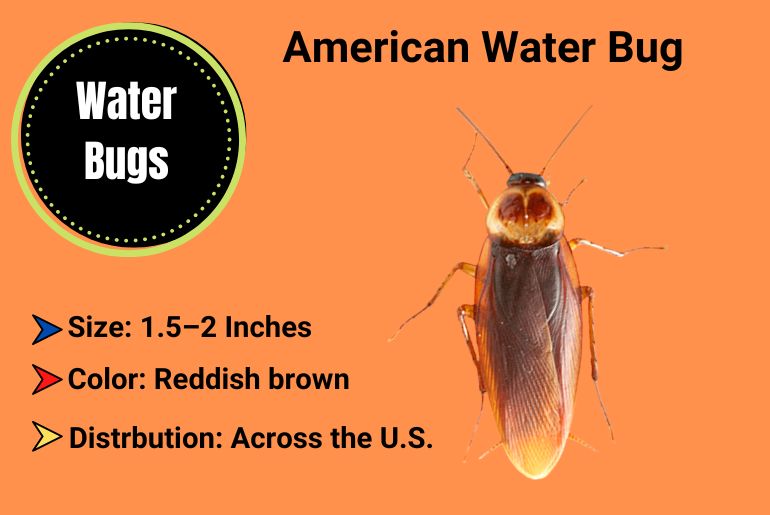
Size and color
The American water bug is a large, dark-colored aquatic insect. Adults can grow over 1.5 inches long, making them one of the largest insects in North America. They are typically brown or black but may also be reddish or mottled.
Distribution
There are many different species of American water bugs, and they are found all over North and South America. Some species are found in freshwater, while others live in saltwater. Some species are even found in the arctic!
Food
American water bugs are voracious predators and will eat anything they can catch. Their diet consists mostly of insects, but they also eat small fish, tadpoles, and carrion. They are especially fond of soft-bodied prey, such as caterpillars and grubs.
Risks
These bugs are risky for human beings in the following ways.
- They may bite if they feel threatened.
- Can transmit diseases to humans.
- They may be a nuisance if they invade homes or other buildings in search of food or water.
American water bug nymph
The American water bug nymph is a small, round creature typically dark in color. They have six legs and two long, antennae-like appendages that they use to sense their surroundings. Water bug nymphs are often found near bodies of water, using their long, powerful legs to swim through the water in search of food.
Giant water Bug
Giant water bugs are large, predatory insects that live in freshwater. They are excellent swimmers and can even fly short distances. Giant water bugs hunt small fish, amphibians, and even reptiles. They inject their prey with a paralyzing toxin, then suck out their body fluids. Giant water bugs are sometimes called “toe-biters” because their bites can be painful.
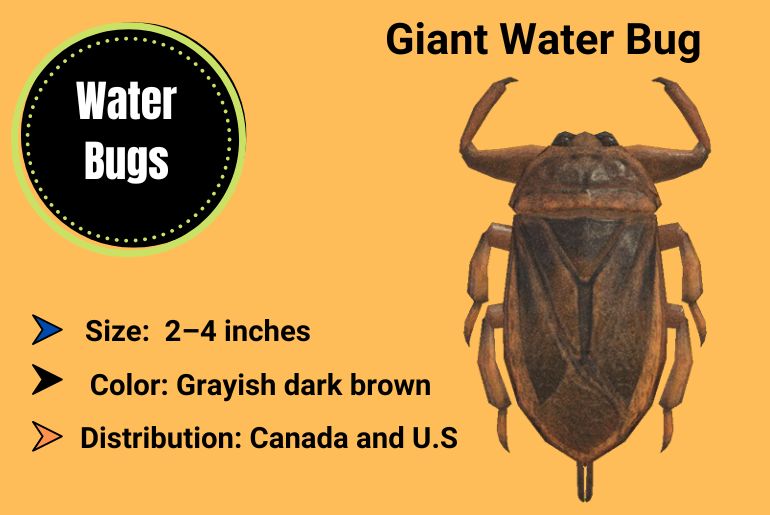
Size and Color
Giant water bugs are large, flat insects growing up to 4 inches long. They are brown or black and have a hard, protective shell. Giant water bugs are predators, using their long, sharp beaks to puncture and inject prey with venom.
Habitat and Distribution
The Giant water bugs inhabit freshwater habitats like ponds, lakes, and marshes. These bugs are good swimmers and often cling to the underside of rocks or other submerged objects. They are distributed throughout the United States and Canada.
Food
Their diet consists mostly of fish, tadpoles, and small amphibians, but they will also opportunistically feed on anything else they can catch, including other insects. They are particularly fond of mosquito larvae. Giant water bugs use their long, sharp beak to puncture their prey and inject it with a paralyzing toxin. They then suck out the prey’s body fluids, leaving only the exoskeleton behind.
Risks
They are capable of inflicting a painful bite, and their saliva can cause allergic reactions in some people. Also, the bugs can be a nuisance if they invade homes or other buildings in search of food.
Oriental cockroach (Oriental Water Bug)
The Oriental cockroach is a species native to the eastern United States and southern Europe. It is one of the most common cockroaches in the world and is considered to be a pest in many homes and businesses. The Oriental cockroach is dark brown or black in color and is about 1-2 inches in length. It is a winged insect but cannot fly. The Oriental cockroach is attracted to damp and dark places and is often found in basements, crawl spaces, and sewer systems. It is a scavenger and will eat just about anything, including garbage, food scraps, and dead insects. The Oriental cockroach is not considered to be a health hazard but can be a nuisance due to its foul odor and its tendency to invade homes and businesses.
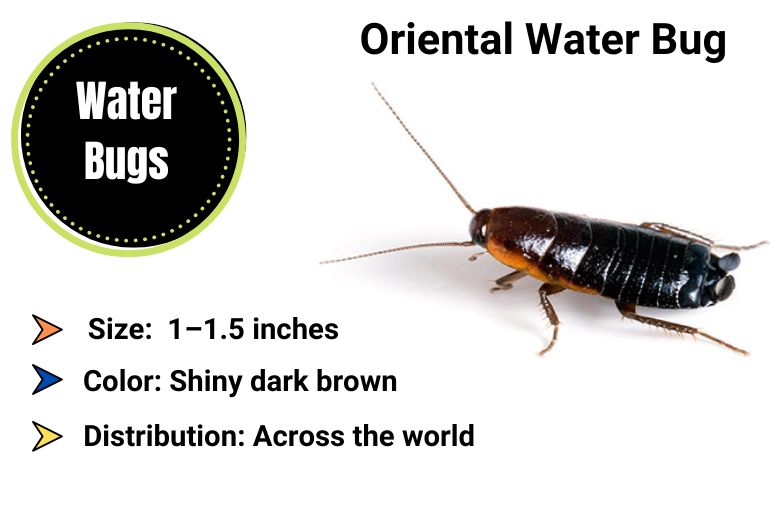
Size and Color
Oriental cockroaches are one of the largest species measuring up to 1.6 inches in length. They are dark brown or black with a glossy body.
Distribution
The Oriental cockroach is commonly found in the eastern and southern United States and parts of Canada, Mexico, Europe, and Asia.
Food
The Oriental cockroach is a voracious eater and will scavenger. They are fond of decaying organic matter like leaves and dead insects. They will also eat small vertebrates like lizards and rodents in the wild.
Risks
They are not known to transmit diseases but can be a nuisance and cause allergies in some people. Oriental cockroaches can also survive in cold temperatures, making them a common pest in the winter months.
Oriental water bug nymph
The Oriental water bug nymph is a small, brownish-black insect with a hard, segmented body. It is typically 1/4 to 1/2 inch long, although some may be larger. The nymphs go through several molts before reaching adulthood, and they may be seen in ponds, streams, and other bodies of water.
Water Scorpion
The water scorpion is a predatory aquatic insect that is related to the true scorpions. They are found in freshwater habitats worldwide and are particularly common in tropical regions. Water scorpions are excellent swimmers and use their long, curved tails to propel themselves through the water. These predators feed on a variety of small aquatic creatures and can be a nuisance to fishermen and swimmers alike. Water scorpions are relatively harmless to humans, but their sting can be painful.
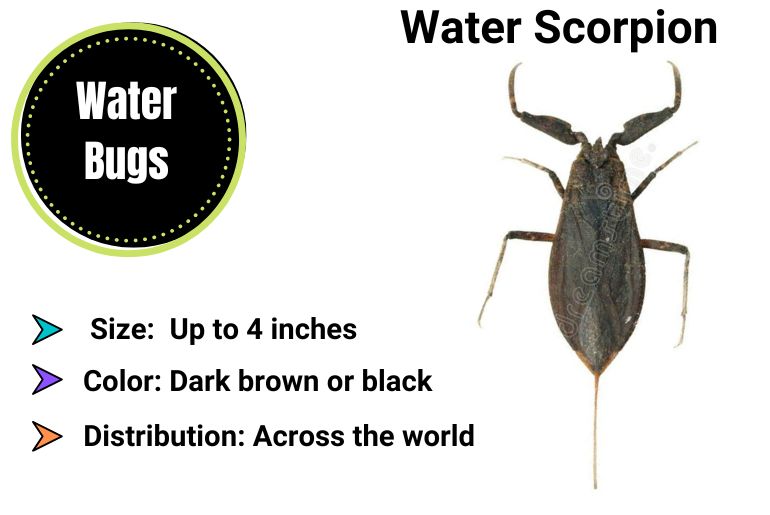
Size and Color
They are typically dark brown or black in color and can grow to be up to 4 inches in length. Water scorpions have long, segmented bodies and large, powerful pincers that they use to capture their prey.
Risks
If a water scorpion bites you, you may experience severe pain, swelling, and itching. In some cases, the venom can cause an allergic reaction, and you may need to seek medical attention.
Distribution and Habitats
They are commonly found near bodies of water, such as ponds, lakes, and streams. In some cases, they may even be found in the ocean. Water scorpions inhabit countries such as Australia, Brazil, Canada, China, France, Germany, India, Italy, Japan, Mexico, Russia, Spain, and the United Kingdom.
Water boatmen
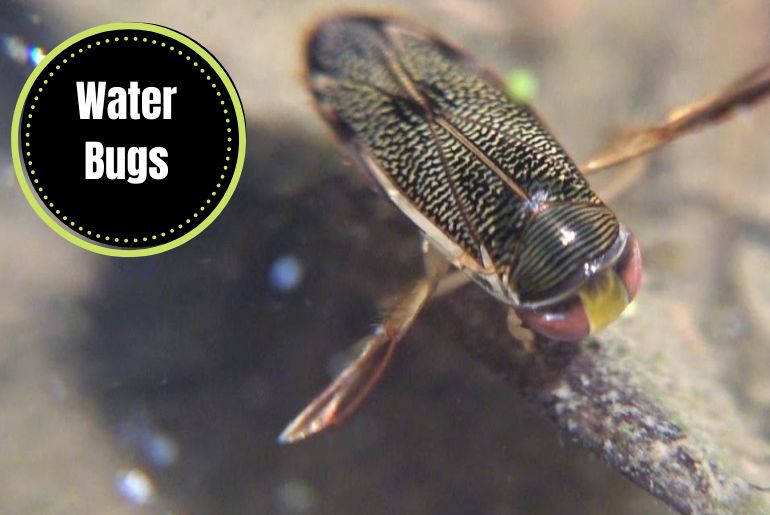
Water boatmen are small, water-dwelling insects that are found in freshwater habitats all over the world. They are excellent swimmers and can often be seen paddling about on the surface of ponds and lakes. Although they are often mistaken for water beetles, water boatmen are true bugs in the Hemiptera order. They are predators, and their diet consists mostly of other small aquatic insects and larvae. They are an important part of the food chain in many freshwater ecosystems. Water boatmen are also known to bite humans if they are disturbed or handled. Their bites are not harmful but can be quite painful.
Backswimmer
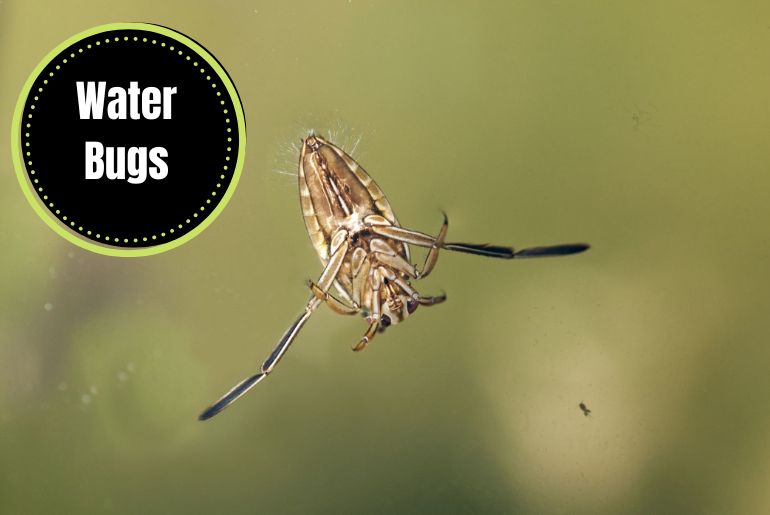
The backswimmer is a small aquatic insect that is easily recognized by its swimming style. It swims upside down and backward, using its long legs to prop itself up in the water. The backswimmer is a voracious predator, feeding on small insects and larvae. It is a common sight in ponds and lakes, where it can be found swimming among the vegetation.

